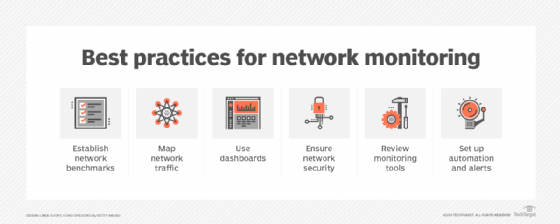Top 6 network monitoring best practices
Benchmark metrics, customizable dashboards and automation are all best practices in network monitoring. Network admins can use them to optimize performance and minimize threats.
The number of networking tasks for which IT teams are responsible can seem overwhelming. In this era of dynamic processing -- from cloud scalability to microservices architectures -- management tools and automation platforms are pervasive.
It becomes essential to formulate best practices to monitor network health and minimize downtime. Once these steps are in place, network teams can efficiently fine-tune networks to establish a baseline of network performance and quickly identify issues as they occur.
Below are some best practices for effective network monitoring and the benefits associated with each step.
1. Establish network benchmarks
Benchmarks and baselines provide a reference point for normal network behavior. Network administrators can apply benchmarks to a diverse set of elements and metrics that include the following:
- Bandwidth.
- CPU usage.
- Memory consumption.
- Error rates.
- Latency.
- Packet loss.
- Rack temperatures.
- Device operation.
These indicators ensure normal operational standards for future comparisons and offer a basis to customize anomaly detection and help with troubleshooting. For example, teams can measure CPU utilization, assess latencies and track network usage to optimize bandwidth and performance.
With this best practice in place, teams gain a real-time, centralized overview of bandwidth utilization across the network infrastructure.
2. Map network traffic
The goal of network performance monitoring is to identify heavy data traffic areas and prioritize mission-critical applications and services. This practice helps pinpoint latency issues, in which data is delayed as it transfers across the network.
A key procedure is to regularly monitor these data exchanges, using tools such as ping and traceroute. Ping is a command-line tool that measures round-trip time, while traceroute shows the path of data packets and latency at each exchange. Network engineers can respond to issues with accuracy and use these tools to address bottleneck issues, calculating the processing power required for programs and data on a network.
These tools help with network mapping by providing insights into network topology, device connectivity and performance. Network admins can also use network mapping tools, such as Nmap, Microsoft Visio and Lucidchart, to visualize the network architecture.

3. Use dashboards
Customizable dashboards enhance visibility through real-time graphs and reports on component performance along with email and text alerts. These notifications can be integrated with AIOps platforms to reinforce best practices and accelerate issue resolution using root-cause analysis.
Dashboards help network admins track the network KPIs that matter to them, enabling real-time visibility into network traffic, data visualization and capacity planning.
4. Ensure network security
Traffic monitoring and log analysis are essential tasks in network monitoring, as they help network admins identify anomalies, detect intrusions and assess authentication attempts. Tools like intrusion detection and prevention systems can also help pinpoint potential threats and unusual network or end-user behavior.
5. Review monitoring tools
In general, network monitoring tools are available as three types:
- Simple Network Management Protocol (SNMP).
- Flow-based monitoring tools, such as IP Flow Information Export, NetFlow and sFlow.
- Automation tools.
Administrators and engineers use SNMP to interact with network devices and gather data from routers, switches, firewalls and servers. Teams use flow-based tools to monitor traffic and analyze data flow information, such as packets passing between IP addresses. Another option is to adopt proactive network monitoring platforms to automate many monitoring processes.
6. Set up automation and alerts
Automation is critical for the following tasks:
- Sustain high performance.
- Identify security threats and vulnerabilities.
- Accelerate recoveries.
- Minimize disruptions.
Software tools further extend checks, redundancies and backups to ensure desired state and consistent performance.
However, IT leaders can create nearly fail-safe environments by combining best practices with automation to customize alerts, access single-pane views of configuration details, track performance and document changes for compliance.
Key takeaways
Adopting best practices for network monitoring not only eases collaboration between IT team members, but it clearly defines responsibilities and accelerates response times to critical issues.
Moreover, while automation remains a key differentiator, it doesn't diminish the effectiveness of an immediate, hands-on approach. For example, conflicting query results can occur when an automation GUI falls out of sync with the command line. Team members can resolve those discrepancies directly by accessing the command line for more granular analysis.
By following these best practices, network teams can proactively monitor and optimize their networks.
Kerry Doyle writes about technology for a variety of publications and platforms. His current focus is on issues relevant to IT and enterprise leaders across a range of topics, from nanotech and cloud to distributed services and AI.








